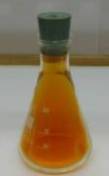






Between nitrogen dioxide $(NO_2$ , a brown gas ) and dinitrogen teroxide $(N_2O_4$, a colourless gas ) two opposed reactions take place: $N_2O_4$ $\longrightarrow$ $2NO_2 (1)$ $N_2O_4$ $\longleftarrow$ $2NO_2 (2)$ Let's suppose, that at a given temperature it would be possible to start with pure $N_2O_4$. First, there would only be reaction (1) with rate (law of rate): $v_1$ $=$ $k_1[N_2O_4]$ As $N_2O_4$ disappears and $NO_2$ appears, the reaction (2) with rate (law of rate) $v_2$ $=$ $k_2[NO_2]^2$ from zero in the beginning increases because $[NO_2]$ increases, whereas the rate of reaction (1) decreases because $[N_2O_4]$ decreases. The two rates must come to be equal! An equilibrium is established: $NO_2$ disappears as rapidly by the reaction (2) as it appears by the reaction (1) and so we can write: $v_1$ $=$ $v_2$ $k_1[N_2O_4]$ $=$ $k_2[NO_2]^2$ $\frac{[NO_2]^2}{[N_2O_4]}$ $=$ $\frac{ k_1}{ k_2}$ $\frac{[NO_2]^2}{[N_2O_4]}$$=K_c $ As $k_1$ et $k_2$ are rate constants depending on the temperature, $K_c$ $=$ $\frac{ k_1}{ k_2}$ is a constant depending on the temperature
The equilibrium: $N_2O_4$ $\rightleftarrows$ $2NO_2$ obeys the law: $K_c$ $=$ $\frac{[NO_2]^2}{[N_2O_4]}$ $K_c$ is the equilibrium constant. $K_c$ depends only on the temperature.